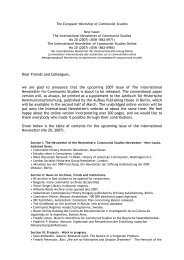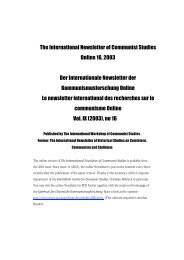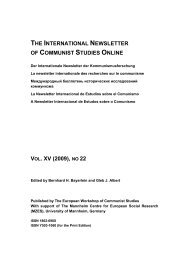Vol. XIII (2007), no 20 - The International Newsletter of Communist ...
Vol. XIII (2007), no 20 - The International Newsletter of Communist ...
Vol. XIII (2007), no 20 - The International Newsletter of Communist ...
Sie wollen auch ein ePaper? Erhöhen Sie die Reichweite Ihrer Titel.
YUMPU macht aus Druck-PDFs automatisch weboptimierte ePaper, die Google liebt.
<strong>The</strong> <strong>International</strong> Newletter <strong>of</strong> <strong>Communist</strong> Studies Online <strong>XIII</strong> (<strong><strong>20</strong>07</strong>), <strong>no</strong> <strong>20</strong> 137<br />
newspapers in the area but the suppression <strong>of</strong> Finnish communism and the ban <strong>of</strong> Kansan<br />
Tahto in 1930-45 gave the bourgeois newspaper in Oulu an advantage which Kansan Tahto was<br />
<strong>no</strong>t able to catch up. With the circulation between 13000 and 23000 it was, however, the<br />
second largest newspaper in Northern Finland from the 1940s to the 1980s. <strong>The</strong> depression <strong>of</strong><br />
the early 1990s shook its eco<strong>no</strong>my very badly; it lost almost 75 per cent <strong>of</strong> its advertising<br />
incomes and had to cut the amount <strong>of</strong> editors and days <strong>of</strong> publication which diminished its<br />
circulation considerably.<br />
Kansan Tahto has been an obedient organ <strong>of</strong> the movement it has belonged to. Its own ideas<br />
were strongest in 1907-14 when Yrjö Mäkelin regarded co-operation with the bourgeois<br />
parties for the defence <strong>of</strong> Finnish auto<strong>no</strong>my as possible while the leadership <strong>of</strong> the SDP in<br />
Helsinki relied on the activities <strong>of</strong> the labour movement alone. <strong>The</strong> ideas <strong>of</strong> the communist<br />
movement declared that the newspapers should be subordinated to the party. Though these<br />
ideas were accepted by the SSTP, they were <strong>no</strong>t applied to newspapers. Thus the editors and<br />
the local associations behind Kansan Tahto decided who its editors were and what was to be<br />
published in it. New communist doctrine could, however, achieve strong influence, and in the<br />
end <strong>of</strong> the 19<strong>20</strong>s Kansan Tahto was very eager to propagate the ideas <strong>of</strong> a new revolutionary<br />
period. It was, however, the general commitment to the communist movement which<br />
contributed to the ban <strong>of</strong> the newspaper from summer 1930 to autumn 1945.<br />
<strong>The</strong> same kind <strong>of</strong> strong commitment was evident as Kansan Tahto started to appear after<br />
the long interval in 1945; it formulated its stance only after some person in the leading<br />
position had made a statement <strong>of</strong> the issue. <strong>The</strong> commitment <strong>of</strong> the newspaper to the twopolar<br />
world was also evident in 1945-56. <strong>The</strong> revelations <strong>of</strong> the <strong>20</strong> th congress <strong>of</strong> the<br />
<strong>Communist</strong> Party <strong>of</strong> the Soviet Union did <strong>no</strong>t arouse any particular expressions in the paper.<br />
This can be explained by the fact that many editors were socialised in the labour movement<br />
in the late 19<strong>20</strong>s.<br />
Kansan Tahto started a rebellion against the narrow-mindedness and orthodoxy <strong>of</strong> the<br />
communist movement in October 1964. <strong>The</strong> actual starting point was the dismissal <strong>of</strong> Nikita<br />
Khrushchev after which the newspaper started a new section for readers’ discussion unusual<br />
in the labour newspapers at that time. All the other newspapers <strong>of</strong> the SKDL joined the<br />
discussion which dealt with all kind <strong>of</strong> themes but also the character <strong>of</strong> the revolution in<br />
Finland, the necessity <strong>of</strong> the dictatorship <strong>of</strong> the proletariat, the attitude to the social<br />
democrats and possibilities <strong>of</strong> the co-operation between the parties <strong>of</strong> the labour movement.<br />
<strong>The</strong> results <strong>of</strong> these discussions were reflected in the reformed programmes <strong>of</strong> the SKDL and<br />
SKP. After 1969 the whole movement, however, returned to “the old truths”. Thus Kansan<br />
Tahto, contrary to the leadership <strong>of</strong> the SKDL and SKP, did <strong>no</strong>t strongly criticise the<br />
occupation <strong>of</strong> Czechoslovakia in 1968 and did <strong>no</strong>t allow criticism <strong>of</strong> the Soviet Union on its<br />
pages. In the internal disputes <strong>of</strong> the Finnish communist movement it, however, followed the<br />
majority line, though it was <strong>no</strong>t very enthusiastic about the deals made between the majority<br />
and mi<strong>no</strong>rity and considered them dangerous for the rules <strong>of</strong> the party.<br />
During its hundred years Kansan Tahto has filled its promise to be the organ <strong>of</strong> the poor in<br />
Northern Finland in a splendid way. In its first years the newspaper, however, tried to be a<br />
"teacher" and did <strong>no</strong>t accept the local forms <strong>of</strong> trade union organisation, that is various cooperatives<br />
among the harbour workers. After the Civil War Kansan Tahto did <strong>no</strong>t start to














